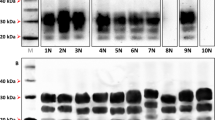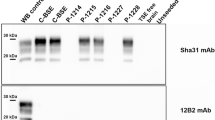Abstract
Four chronic subacute spongiform encephalopathies—Kuru and Creutzfeld–Jakob diseases of man, transmissible encephalopathy in mink and scrapie in sheep—are caused by slow viruses with unconventional biological and biochemical properties1–4. Since the transmission of the scrapie agent to mice5 and the comparative histological analysis of Kuru in man6 and of scrapie in the mouse, scrapie–mouse systems have become important models of spongiform encephalopathies. The predominant histopathological lesions (for review see refs 2, 4) found in these diseases result from nerve cell degeneration7. It seems that, in contrast to diseases of the nervous system caused by conventional viruses, perivascular leukocyte infiltrations do not play any part in the progression of spongiform encephalopathies and it is not known whether leukocyte infiltrations can be induced by unconventional slow viruses. Here we report that scrapie infection can indeed produce such lesions in mice.
This is a preview of subscription content, access via your institution
Access options
Subscribe to this journal
Receive 51 print issues and online access
$199.00 per year
only $3.90 per issue
Buy this article
- Purchase on Springer Link
- Instant access to full article PDF
Prices may be subject to local taxes which are calculated during checkout
Similar content being viewed by others
References
Gibbs, C. J. Jr & Gajdusek, D. C. Perspect. Virol. 10, 161–198 (1978).
Lampert, P. W., Gajdusek, D. C. & Gibbs, C. J. Jr Am. J. Path. 68, 626–651 (1972).
Kimberlin, R. H. Sci. Prog. Oxf. 63, 461–481 (1976).
Fraser, H. in Progress in Neurological Research (eds Behan, P. O. & Rose, F. C.) 194–210 (Pitman Medical, London, 1979).
Chandler, R. L. Lancet i, 1378–1379 (1961).
Hadlow, W. J. Lancet ii, 289–290 (1959).
Lampert, P., Hooks, J., Gibbs, C. J. Jr & Gajdusek, D. C. Acta Neuropath. 19, 81–93 (1971).
Eklund, C. M., Hadlow, W. J. & Kennedy, R. C. Proc. Soc. exp. Biol. Med. 112, 974–979 (1963).
Hadlow, W. J. Res. Vet. Sci. 2, 289–314 (1961).
Wilson, D. R., Anderson, R. D. & Smith, W. J. J. comp. Path. 60, 267–282 (1950).
Zlotnik, I. & Rennie, J. C. J. comp. Path. 67, 30–36 (1957).
Schäfer, W. Z. Naturf. 34 c, 306–309 (1979).
Kimberlin, R. H. J. Neurochem. 19, 2767–2778 (1971).
Kimberlin, R. H. & Walker, C. A. J. comp. Path. 89, 551–562 (1979).
Pattison, J. H. J. comp. Path. 75, 159–164 (1965).
Hunter, G. D., Gibbons, R. A. & Kimberlin, R. H. J. comp. Path. 79, 101–108 (1969).
Sotelo, J., Gibbs, C. J. Jr & Gajdusek, D. C. Science 210, 190–193 (1980)
Author information
Authors and Affiliations
Rights and permissions
About this article
Cite this article
Museteanu, C., Diringer, H. Perivascular infiltrates of leukocytes in brains of scrapie-infected mice. Nature 294, 360–361 (1981). https://doi.org/10.1038/294360a0
Received:
Accepted:
Issue Date:
DOI: https://doi.org/10.1038/294360a0
Comments
By submitting a comment you agree to abide by our Terms and Community Guidelines. If you find something abusive or that does not comply with our terms or guidelines please flag it as inappropriate.



